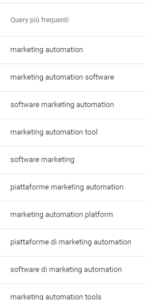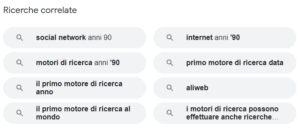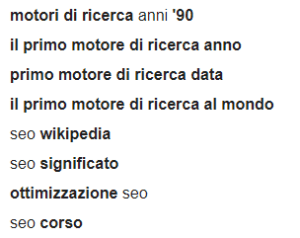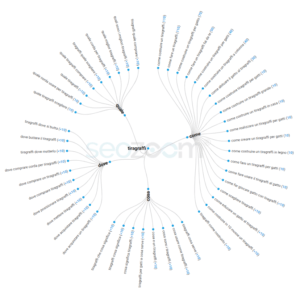
Indice
What is a Seo-Driven Editorial Calendar and Why is it so Underrated?
A SEO-Driven Editorial Plan is like most editorial plans, but additionally it takes into account the current trends based on user searches through a search engine, in over 90% of the cases through Google (both in Italy and abroad).
Generally speaking, those involved in the implementation of an editorial calendar tend to align themselves with the internal company data when orchestrating the work plan, however, I often notice a lack of integration on SEO level.
By simply doing a quick quantitative search through SeoZoom between “editorial plan” and “seo editorial plan”, we come to see that the ratio of the two is almost 100 to 1 (88 to 1 to be precise). Integrating a SEO-driven analysis means changing one’s perspective: from listening exclusively to our clients needs (and thus creating content following the consequent editorial lines), we pass to the understanding of our clients’ customers’ needs (that is, the end user). As a consequence, the focus will now be: what they say, how they say it and why they say it.
I believe this approach was born from 3 main factors:
- The journalistic method of creating an editorial plan is to exclusively push content to users, bombarding them with material they might not even be interested in. However, we know very well that the logic behind a search comes from the inner need of the person behind the screen.
- Until not long ago the individual responsible for SEO was considered somewhat of a tech genius/magician (when there were measurable results)
- In business, those who deal with the creation of editorial calendars have a social oriented training, less focused on the analysis of the search intent.
The Advantages of a SEO-Driven Editorial Calendar
Content is king! Or is it? By analyzing content as a product, we have to step into the shoes of a product manager and evaluate its life cycle (and therefore the ROI of our content). I often wonder how much it might be: an hour, a day, a week, a year?
Content focused on research analysis generally has a much higher life cycle (again depending on various SERP imbalances, new competitor entries, etc.) and is more likely to bring qualified traffic to the site.
Why it’s Useful: Site Reachability and Performance
SEO analysis can help to understand exactly which searches are bringing traffic to your website, who your direct online competitors are and what potential opportunities lie ahead of you.
Alongside the fundamental technical aspects of your site, whether it be corporate or ecommerce, keyword analysis can essentially allow us to trace the route along which your site will appear.
When talking to my clients we first discuss their positioned keywords to start off with a concept already in use, though I prefer the concept of topics because if the type of content we are going to create is relevant, the page will position itself not only for the chosen keyword, but also for other keywords with the same search intent.
Allow me to present you an example taken from our website:
We wanted to position ourselves on the topic [software marketing automation]. In addition to the main keyword our content also achieved a good average positioning for other searches, such as:
Now, without further ado, let me share with you the steps I take to create a SEO-driven editorial calendar:
- The first step is to deeply get to know the clients’ website (from both a technical and a marketing point of view)
- Understand which of the products/services are most important to your client, and what is their Relative Performance (this information is either provided by the client or is found in Google Analytics)
- Analyze the positioning of the website
- Get to know the both the direct and potential competition, and understand their positioning
This top-down approach seeks to identify the big picture and all of its components.
II. Why it’s Useful: Finding New Arguments
When delving into user research one always discovers new topics on which to create or deepen a certain content. The Search Engine Results Page gives us several clues, one of which is visible at the bottom of the page: Related Searches.
Not to mention the Google Suggest Tool, which shows us suggestions as we are typing.
Search Intent Analysis
By understanding this research we understand what the user in question wants, and what their goals/needs are. A useful method to study search intent is to categorize them by actions:
- Navigational (go): the user goes to a specific website
- Informational (know): the user is searching for information on a certain topic
- Transactional (do): the user wants to act, for example download a file
Summary
Let’s recap:
- We choose the topics which we set in the editorial calendar.
- We then proceed to identify the specific keywords by understanding the search volumes and seasonality.
- We carry out the analysis of the search intent, thereby understanding what answer our content marketing will have to give.
- Once we’ve arrived at this point, all that remains is to create the content.
Let’s look at a real-life example of a SEO-driven editorial calendar
Let’s imagine we have a company producing goods for pets.
After carrying out a technical analysis and site visibility, we know that the company has a technically functional site and a good UX interface, but is not well positioned for the keywords of its interest.
Within the editorial plan, we know that the product categories of the site are the topics that we must explore to find user searches.
Here’s an example for [cat scratching post] (tiragraffi)
We can see that it’s definitely an interesting topic. Let’s include it in the editorial calendar together with the other topics.
After analyzing what and how users search (taking into consideration our competition), we decide on the keyword: [wooden cat tree] which has a volume of 50 searches per month. We then carry out the subsequent analysis for the creation of our specific type of content. Personally, I don’t think SEO copywriting exists, but if the previous analysis has been done correctly, then the copy will do its job by translating the analytical inputs into content marketing.
In our experience the results can vary from an increase between 10% and 60%, though it also highly depends on the starting point of your clients website. One can never promise a positioning on the first page on Google, so be wary of those who do.
The results – you cannot promise the first page on Google, so be wary of those who do it (Google also says it here) – in our experience they can range from an increase between 10% – 60% in relation to the stage in which you find the customer site. (Google verifies this here)
KPI’s
The only time to overcome any initial resistance is to present the report with the KPIs already agreed with the customer. Everything is questionable, but results aren’t. If you weren’t ranked for a specific keyword before and now you are, that, ladies and gentlemen, is a result. If your organic traffic has increased, that also, is a result. In an awareness phase, the KPIs of a SEO-driven content marketing can be:
- keyword positioning
- organic traffic
The first KPI is always an average position and is never absolute – we are not in the 90s afterall. The second is a value to be analyzed within the various acquisition channels of the site.
Some Useful Tools
There are several valid tools on the market, but since all projects are different, we can not put one single tool above the rest.
Without going too much into detail, here are some of my favourite tools that I use on a regular basis:
- Screaming Frog: spider website crawlers are great tools for carrying out a technical analysis
- Search Console: for totally free, this tool offers a nice overview of our current and potential organic visibility, as well as a technical overview.
- SeoZoom / SemRush: an incredibly useful tool to find out which keywords your competitors are positioned for, helps you find new ones, and much more.
- Google Analytics: a behavioral analysis tool, which gives an overview on the different access channels to our site. Focusing on the organic channel, we can see the increase (or lack thereof) of accesses to our site, setting a comparative time filter.

CEO and Senior Strategist at AI6
Stefano is CEO and senior strategist at AI6, with over 20 years of digital marketing experience, helping Italian brands to increase their digital maturity. Stefano used to be a baseball player on national level but nowadays he prefers playing electric guitar in a rock band.

CEO and Senior Strategist at AI6
Stefano is CEO and senior strategist at AI6, with over 20 years of digital marketing experience, helping Italian brands to increase their digital maturity. Stefano used to be a baseball player on national level but nowadays he prefers playing electric guitar in a rock band.







